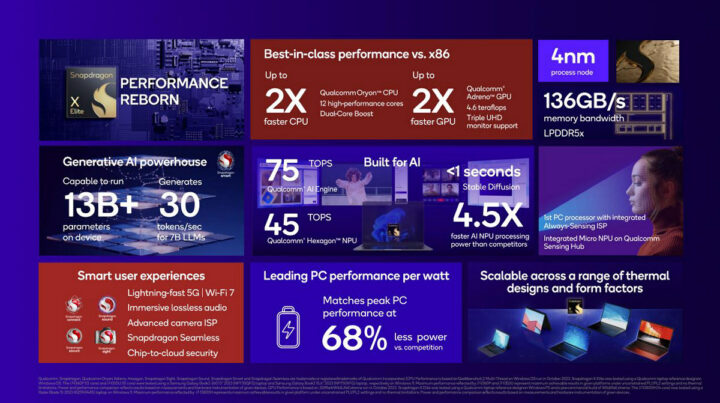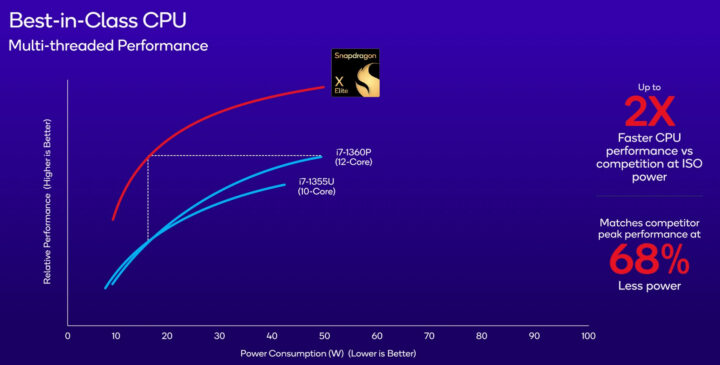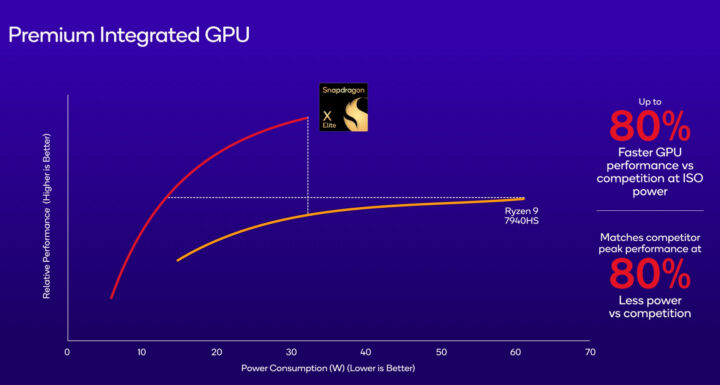Qualcomm has now provided Arm chips for mobile PCs (aka laptops) for several years, but apart from a 20-hour battery life, the performance and price of Snapdragon laptops have often been disappointing. The Snapdragon X Elite aims to change that at least on the performance front.
The new Qualcomm 12-core 64-bit Arm processor is clocked at up to 3.8 GHz boosting to up to 4.3 GHz, and is said to deliver up to twice the CPU performance against the competition (Intel/AMD/Apple) or provides the same level of performance at a third of the power consumption. The SoC will also be able to run on-device generative AI with over 13B parameters thanks to 75 TOPS of AI performance and support the latest wireless connectivity technologies such as 5G and WiFi 7 through external chips from the company.
Qualcomm Snapdragon X Elite specifications:
- CPU – 12-core 64-bit Armv8 Oryon processor clocked at up to 3.8 GHz, or 4.3 GHz for single or dual-core boost
- GPU – Adreno GPU up to 4.6 TFLOPs, DX12 API support
- NPUs
- Hexagon NPU with up to 45 TOPS
- Dual micro NPU on the Qualcomm Sensing Hub
- Up to 75 TOPS in total when combining CPU, GPU, NPU, and micro NPU
- Up to 30 tokens per second for 7B LLMs
- VPU – Adreno VPU
- Encode – 4K60 10-bit encode H.264, HEVC (H.265), AV1
- Decode – 4K120 10-bit decode H.264, HEVC (H.265), VP9, AV1
- Concurrency – 4K60 decode H.264, HEVC (H.265), VP9, AV1 and 2x 4K30 encode H.264, HEVC (H.265), AV1
- Memory – Up to 64GB 8-channel LPDDR5x with 136GB/s bandwidth
- Storage
- NVMe SSD over PCIe Gen 4
- UFS 4.0
- SD v3.0
- Video Interfaces
- eDP v1.4b up to UHD120 (4Kp120) with HDR10
- DP v1.4 for up to 3x displays with to 4Kp60 resolutions with HDR10, or 2x displays up to 5Kp60
- Camera
- Qualcomm Spectra ISP – Dual 18-bit ISPs and always-sensing ISP
- Dual Camera support up to 2x 36 MP
- Single Camera up to 64 MP
- Video Capture up to 4K HDR
- Audio – Qualcomm Aqstic audio, Qualcomm aptX audio
- Wireless connectivity using external chips
- FastConnect 7800
- Tri-band WiFi 7, WiFi 6E, WiFi 6 with up to 4 spatial streams
- Bluetooth 5.4
- Implemented through a WiFi M.2 card over PCIe Gen 3
- Cellular via Snapdragon X65 5G modem-RF system
- Supported features – 5G NR, mmWave, sub-6 GHz, Dynamic Spectrum Sharing (DSS), LTE, CBRS, HSPA, WCDMA
- Peak speeds – Download: 10 Gbps; upload: 3.5 Gbps
- 1,000 MHz bandwidth (mmWave), 300 MHz bandwidth (sub-6 GHz)
- Technologies – Qualcomm Smart Transmit technology, Qualcomm Wideband Envelope Tracking, Qualcomm AI-Enhanced Signal Boost adaptive antenna tuning, Qualcomm 5G PowerSave
- Implemented through a 5G M.2. card over PCIe Gen 3
- FastConnect 7800
- USB – 3x USB Type-C interfaces with support for USB4, USB 3.2 Gen 2, and eUSB2 (Embedded USB 2.0)
- Process – 4nm
Since the GPU only supports the DX12 API, I suppose that means Qualcomm will only support Windows 11 for the Snapdragon X Elite, so any Linux port would have to come from the community. It looks like quite a powerful chip even though the company is not quite explicit with its comparison against competing chips from public information.
But Anandtech has a few slides that chart the CPU performance against Intel Core i7-1360P and Core i7-1355U Raptor Lake processors…
… and the GPU performance against an AMD Ryzen 9 7460HS.
Both CPU and GPU results are really impressive, but the actual performance will ultimately depend on the power limits set in the target device which should be lower in laptops than in mini PCs (if any) in order to extend battery life.
Laptops powered by the Snapdragon X Elite processor are planned for mid-2024, so they would be matched against systems based on Intel Meteor Lake, AMD Ryzen 7000, and Apple’s next-gen M-series chip. You can also check out the product page and/or read the press release for more details.

Jean-Luc started CNX Software in 2010 as a part-time endeavor, before quitting his job as a software engineering manager, and starting to write daily news, and reviews full time later in 2011.
Support CNX Software! Donate via cryptocurrencies, become a Patron on Patreon, or purchase goods on Amazon or Aliexpress









It’s so sad when a company simply lies in their graphs: AMD 7940HS TDP’s is designed to run between 33 to 45-50 watt, NOT 60.
Also – Relative performance? of what? what apps? what games, what CPU?
It’s showing Ryzen performance up to 60W, not only at 60W.
And they compare the performance right at 35W in the chart to show the difference between them
Qualcomm seem to of taken a different take to cores with no energy cores and wow they have upped the clock speed with a crazy dual core turbo
12-core 64-bit Armv8 Oryon processor clocked at up to 3.8 GHz, or 4.3 GHz for single or dual-core boost
I don’t think I have seen Arm @ 3.8Ghz 4.4Ghz is definately new
> with no energy cores
Well, they made a SoC relying on Nuvia server cores and maybe they just lack the DynamIQ/big.LITTLE capabilities?
And now the funny part: ARM thinks Qualcomm lacks an appropriate license for these Nuvia cores and sued Qualcomm. “The trial for the lawsuit is set to begin on September 23, 2024” or just shortly after Qualcomm wants Notebook makers to rely on SoCs with these cores…
> so any Linux port would have to come from the community
Whether these SoCs will ever be able to boot anything other than Windows mostly depends on how the Pluton crap is implemented that is part of Qualcomm’s Silicon.
Fortunately I was wrong wrt Linux support. SoC mainlining already in the making (and the sender domain @quicinc.com suggesting Qualcomm’s IC department being at work)
Qualcomm bought Adreno from AMD/ATI, yet somehow now claims to have surpassed AMD in terms of graphics performance. Yeah, right.
Yeah in 2008. 15 years later, both companies and GPUs architectures are completely different now
“apart from a 20-hour battery life, the performance and price of Snapdragon laptops have often been disappointing”
Exacty. So what is the plan & proposition now? Why would my next (Windows) laptop be a Qualcomm based ARM laptop?
… “AI possible” … that don’t impress me much.
With a 500 euro i3 based Windows laptop, you know what you get. Windows updates and programs for ever, and Linux installable.
With a Snapdragon laptop … who knows?
Looks interesting, but I don’t trust Qualcomm to provide cost-competitive laptops, outperform AMD Phoenix graphics (not to mention Strix Point which it would actually be competing with), and whatever other claims they are making.
I consider the 75 TOPS claim to be complete bunk. Just say 45 TOPS, that’s already good enough against AMD’s XDNA 1st/2nd gen (not sure about Intel Meteor Lake)…… if true.
I’m guessing SemiAccurate will tear them a new one soon.
Heu, what’s happening ?
Anything that shales up the market can be good but price will play an important factor.
It looks as if ARM and Qualcomm will almost certainly have to come to some kind of settlement because the risk to both entities is too great.
Snapdragon based Linux distributions are essentially rare, so I would not expect Qualcomm to be open source friendly from the off and as Linux has such a small base in homes, I would expect them to drag their feet.
In the mean time, Intel/AMD, what have you got up your sleeve?
It could force them to bring forward already completed hardware designs that in normal times they would drip feed to keep markets active.
My impression is that Qualcom has learned very bad behaviour from being a monopolist in the phone world. I don’t see how I could trust them in the PC world.
Are they not the reason that phones have to lose support after about three years, even though the core of the software load is open source?
Correction: ‘lose support after TWO years.